- Address: Side Roppongi Bldg, 1st Floor, 7-17-24 Roppongi, Minato, Tokyo 106-0032
- Number: +81-3-3423-8006
- Price (after tax + tip, excl. drinks): $260
- Courses: (12 main/14 total) 10 savory / 2 palate cleanser / 2 dessert /
- Price/Main Course: $22
- Rating: 20/20
- Value: 4/5
- Dining Time: 133 minutes
- Time/Course (total): 9.5 minutes
- Chef: Seiji Yamamoto (Aoyagi, Tokushima)
- Style: Kaiseki
- Michelin Stars: 3
Reservation available time : 11:30am-6:00pm
Ryugin popped on my radar when Chef Michael Cimarusti (Providence, Los Angeles) mailed me a DVD of Yamamoto performing cooking tricks that resembled a hybrid of Homaro Cantu’s (Moto, Chicago) high-tech-ery and Adoni Aduriz’s (Mugartiz, a favorite of mine) more organic approach. Indeed, as I did more research, I learned that Yamamoto and Aduriz were great friends, citing each other as influences and inspiration. The food at Mugaritz has an underlying Asian twist and it is possible to see how the two could find common ground to push each other further.3 A few inquiries found that, while experimental, Ryugin still had the Japanese attention to ingredient quality. The restaurant seemed to be at the forefront of an Eastern response to the largely Spanish molecular gastronomy “movement.” – ChuckEats on Ryugin.
Recently, I was staying in Tokyo for 6 days, and came in without a single booking for any restaurant. On a lazy Tuesday night, I managed to get a same-night table at the kaiseki (Japanese multi-course) specialists Ryugin. Weeknight tables are easier to get, since a great deal of fine dining is consumed by the professional class, which makes Friday-Sunday the busy days.
Ryugin is the brainchild of chef Seiji Yamamoto, who specialises in updating the traditional Japanese set-meal “kaiseki” with the latest molecular techniques, in what might be dubbed “molecular kaiseki”. Chef Yamamoto has been known to make burdock root corks for faux-wine, and his famous 196 degree series of fruit desserts involve some molecular trickery. The restaurant is located in gaijin work-and-play area, Roppongi Hills, and Chef Yamamoto has in the mean-time opened a branch serving the same innovative “molecular kaiseki” cuisine in Hong Kong.
Fiercely colourful crockery line the tables, in an intimate 26-seater restaurant, which is done is an classic black Japanese style, (similar to the l’Atelier de Joel Robuchon colour-scheme.) It is ranked #2 in Asia for 2013 by San Pellegrino, just behind The Creations of Narisawa.
(In spite of the tongue-in-cheek title, liquid nitrogen was only used once, for one of the desserts. The meal was still focused on (and achievable with) traditional cooking techniques, with premium ingredients)
____________
Summer Menu 2013


(cold) Grilled Corn Small Egg Custard with Fresh Sea Urchin and Fragrance of 3 varieties of Onions (5/5)
A simple pairing of egg custard and uni (sweet). 3 types of onions refer to green onion flowers (pictured), fried onion (brown bits pictured), diced onion (the white cubes). Showcased delicate raw sweet smell of spring onions without the bitterness.

 (hot) Seasonal Vegetables with Pine Nuts dressing. Array of Flavors and Textures in one plate. (4.75/5)
(hot) Seasonal Vegetables with Pine Nuts dressing. Array of Flavors and Textures in one plate. (4.75/5)
“30 kinds of vegetables”. The salad, with crunchy vinegared bamboo shoots, pine-nuts, cucumber, savory green paste, mushrooms, was an upscale of an form of Asian vegetable medley. The salad tasted intensely of mushrooms and bamboo, and clearly labour-intensive. (as with Michel Bras’s gargouillou, and Alain Passard’s one-leaf-at-a-time approach to salads)
In Singapore, a similar dish called 盆菜 “pen cai” is made with tons of fungus and beehoon.


(cold) Simmered Summer Vegetables and Cold Shabu-Shabu Beef with Kinome flavor (5/5)
The shabu-shabu tasted delicate and beefy, and falling-off tender. The jelly is made from boiling bonito fish, and lended a umami flavor to the dish. Blue Eggplant underneath the shabu-shabu, was from the Yokohama region. The star of the dish was kinome, leaves of the Japanese Ash (AKA Szechuan Peppercorn). Imagine lemongrass, but without the acrid lime taste. If lemongrass’s sourness can be a sawtooth wave, kinome resembles more a gentle sine wave. This was one of my favourite courses. Harmoniously composed.
(By comparison, the next night, at Tapas Molecular Bar, the beef was tender by virtue of pounding into submission wagyu beef with nitrous oxide for 6 hours.)


(hot) Ichiban Dashi Soup. Pike Eel with Egg Plant stuffed inside in Summer Presentation (3.5/5)
The eggplant is folded within the pike eel. The pike eel was largely tasteless and flaky (so I guess I was to focus on its texture), the eggplant sweet; together they went well. I was told to eat before it disintegrates, since the geometric folding would not last long in the soup.
Alas! Given my inexpert chopstick handling, as well as the size of the morsel (two normal chopsticks full), they went together for 2 bites at most. This is a cutlery conundrum, calling for a new variant – gentle spatula tongs.
But a more experienced epicure educates:
There is no ingredient that tests the knife skills of a chef more than hamo, pike conger eel, which has rows of tiny coarse bones that are impossible to remove. Only an experienced chef with superior knife skills can perform honegiri (which means ‘bone cutting’ in Japanese), a process of making precise incisions into the bones without cutting through the skin or destroying the flesh. When a properly incised piece of hamo is blanched in hot water, it should blossom like a chrysanthemum flower with perfectly even sections, and create a light and fluffy texture. The hamo by Chef Yamamoto at Ryugin was the most perfect demonstration of hamo workmanship that I have seen to date. It was stuffed with sweet caramelized kamo-nasu eggplant and served in a wonderful bonito ichiban dashi. – Tomostyle

The revelation of the dish was the water shield, or mugwortfrom the soup. This gelatinous herb is called “gin sai” or water shield. It’s crunchy inside and jello outside, like a natural red ruby (Thai dessert), which has a crunchy chestnut core surrounded by flour.

(cold) Today’s Array of Ocean’s Delicacy. RyuGin style (5/5)
Clockwise from 8 o’clock:
1. Squid and prawn in Japanese soy sauce.
2. Lightly smoked bonito with Japanese mustard.
3. Flatfish with lemon juice.
4. Roasted potato stems with seaweed [texture of bai cai, seaweed umami]
5. Squid and seaweed.
Center:
6. Abalone and Crab Salad
Excellent.




(hot) RyuGin’s famous Summer Dish: Swimming Ayu fish Grilled over Charcoal with Bamboo Aroma (5/5)
Ayu is a Japanese river fish; they were grilled in swimming position. Sauce is watermelon-pepper. (Ayu has a bittersweet part in its head, which I am told is the source of a watermelon flavour in the head). Advised to eat from crunchy head (w/o sauce) to crunchy tail (w/ sauce). Fantastic in conception and the fish were expertly grilled. The watermelon flavour in the ayu is a sort of bitter-sweet.

Cherry pickled with ginger
Palate refresher. I am quite full at this point.

Simmered preparation in Luxurious presentation – Soft Simmered Octopus – Simmered Abalone – Shrimp Ball and Green Peas (4.75/5)
Technically expert simmering with a winter melon piece draped over it.
The deviation from Chinese simmering technique came from the green peas! Crunchy like slightly simmered water chestnut. (“wakamame” peas?)


Pork Neck Grilled on Charcoal and Straw Smoked with Wild Honey Soy Sauce and Mustard (5/5)
Pork neck was fatty and delicious.
Young corn had its thinking cap on.

(hot) Pike Eel Scramble Eggs over the Rice Cooked from the Pike Eel Broth. Miso Soup and Pickles. (3.5/5)
Rice was unspectacular, but the pickled sardines were very good.
 Refresher
Refresher

(off-menu) Chicken Rice Ball
Very fragrant. You can see the many herbs that went into it.

Refresher
hmm…

I broke it with a tap of my spoon… (on instructions) 
(cold) (hot) Roppongi’s special. Small piece of Ripe Mango. (5/5) !!!
oh!
A delicate bijou (of mild-tasting sugar?) coloured and shaped to look like a mango, containing freeze-dried mango powder, is broken by the diner and afterwards mixed with warm mango poured into the diner’s plate. This is the signature minus-196 degree dessert from RyuGin, which has been used for apples and peaches too, among others. (minus 196 is the boiling point of liquid nitrogen).
spectacular.
EDIT: here’s a video that goes into the complicated process of making one of these: http://en.rocketnews24.com/2013/07/05/watch-how-to-make-one-of-japans-elite-restaurants-desserts/

(hot) (cold) Baked Ginjou Sake Oyuki Souffle, and Feathery Soft Served Ice Cream (5/5)
The premium sake souffle tasted like premium sake, which is the highest compliment I can give this dish. (and it goes all the way down into the base of the box).
Ryugin keeps getting better and better, living up to its promotion to 3 Michelin stars. Chef Seiji Yamamoto runs a tight ship at his Roppongi restaurant where the service and the courses seem to flow effortlessly. A recent revisit was right up there as one of the best meals of my life, and the highlight for me was their autumn harvest sake dessert. I went back and forth with my spoon, enjoying both the silkiness of the cold amazake soft serve and the warm fluffiness (and such enticing aromas!) of the sake soufflé. The juxtaposition of temperatures and textures was both pure genius and pure pleasure. – Tomostyle

Matcha
Very bitter Japanese green tea, palate cleansing and bracing. The sequence of dishes is brought full circle; I am again ejected into the starry Tokyo night.
____________
My general thoughts on Ryugin:
- Very theatrical. Most theatrical being the roasted swimming Ayu (river fish), and the Minus-196 Mango.
- Their eggplants are very good.
- Water shield, and kinome are herbs that should be used more often.
- Bonito, which formed the base of the shabu-shabu jelly, is very versatile (dried bonito flakes are often used in Japanese home-cooking).
What I was impressed with was the high standard of imagination in every dish. Seiji Yamamoto has a perfectionist streak, and it shows in the plating and presentation of every dish. A beautiful dinner.
Verdict: 20/20
Memory: Uni Custard, Shabu-Shabu in Bonito Jelly, Swimming Ayu, Grilled Pork Neck, Minus-196 Mango, and Sake Souffle.
Tags: 3* Michelin, japan 2013, molecular, seiji yamamoto, souffle
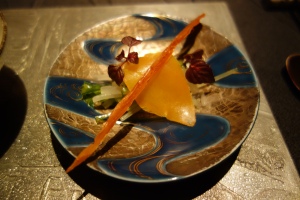


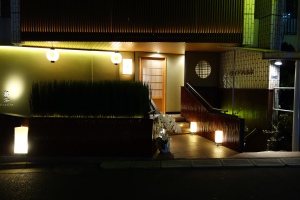
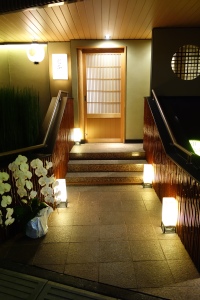
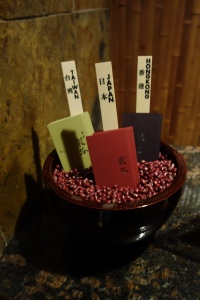
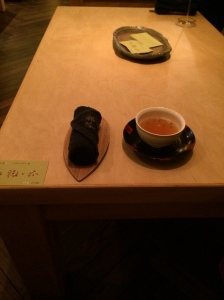
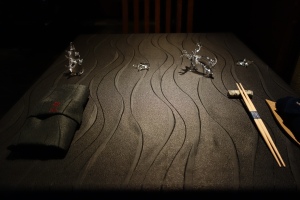
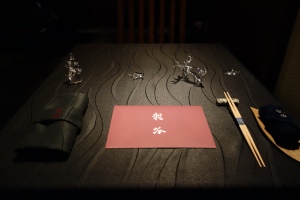
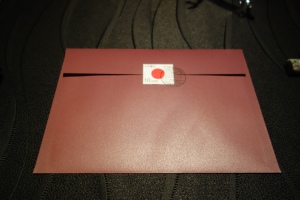
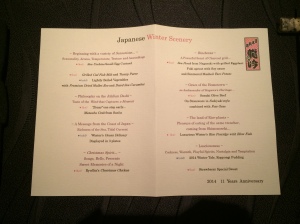
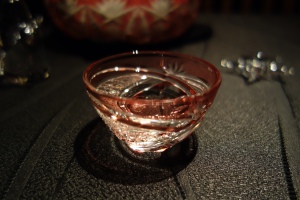
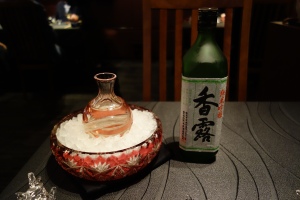
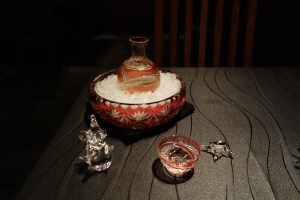
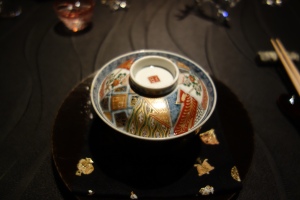
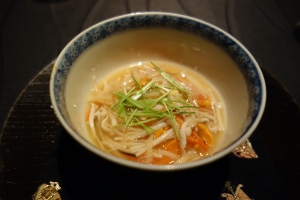
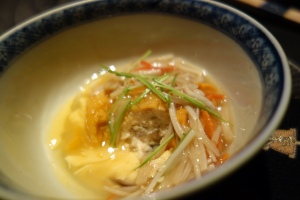
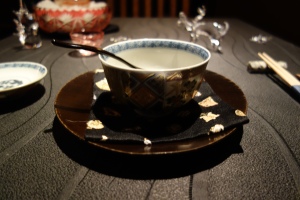
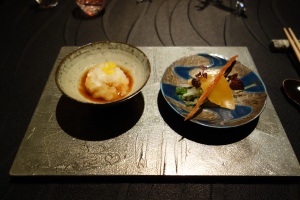
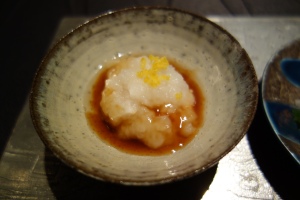
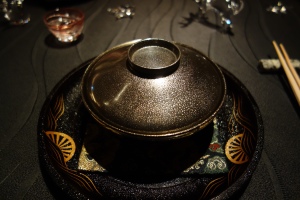
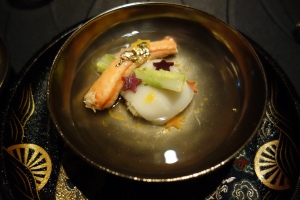
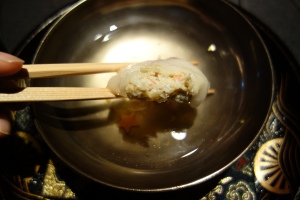
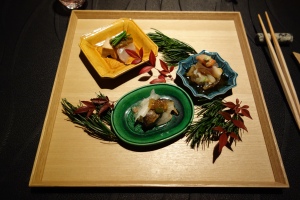
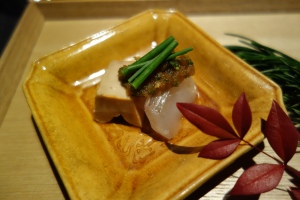
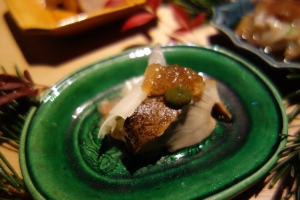
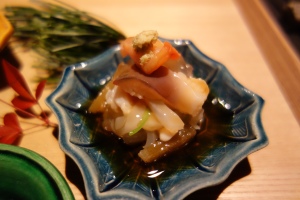

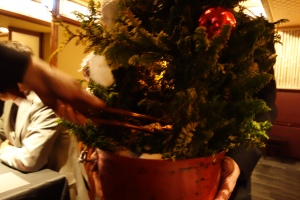


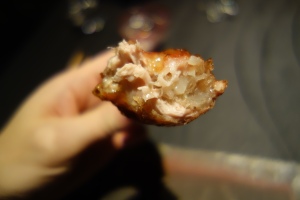

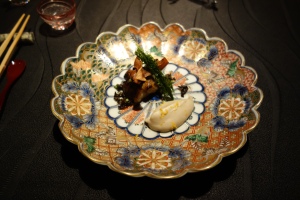
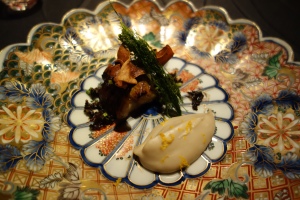
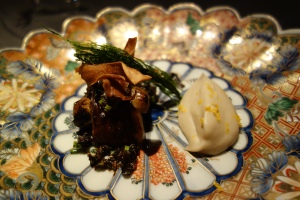
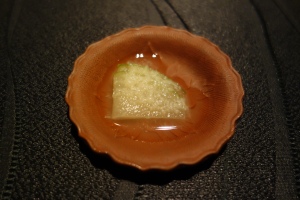
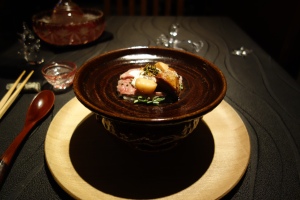
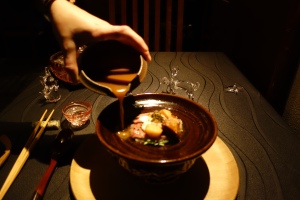


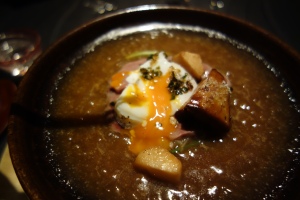
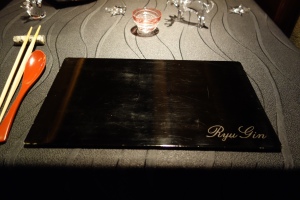
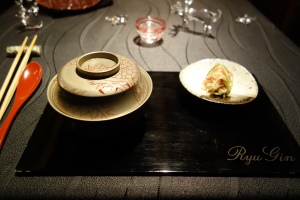
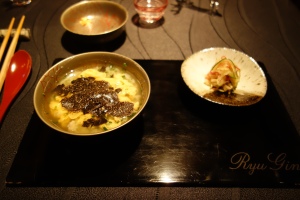
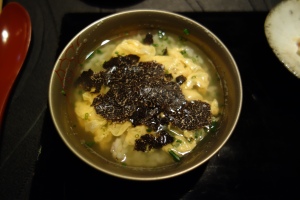
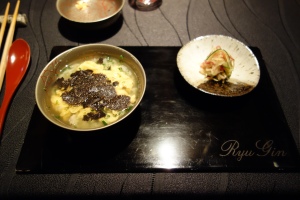
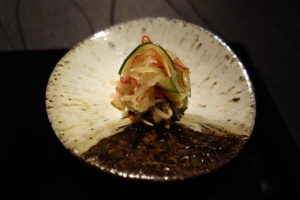
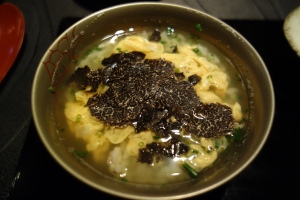

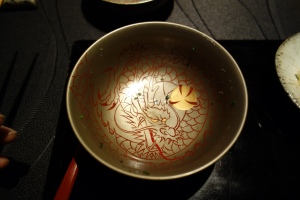
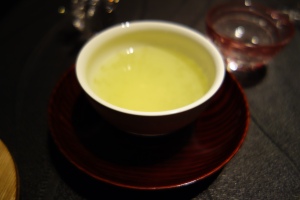
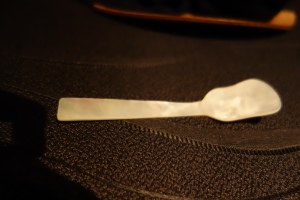
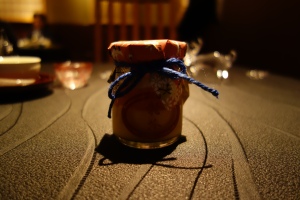
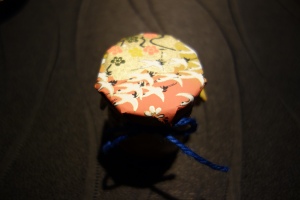

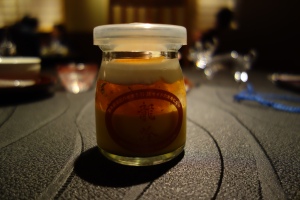
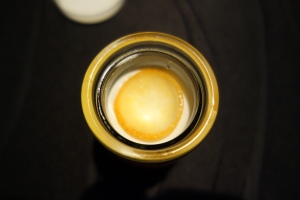
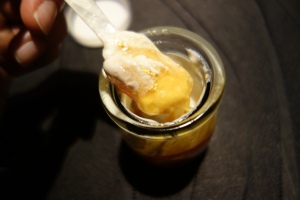
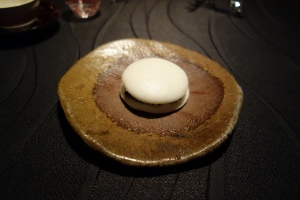
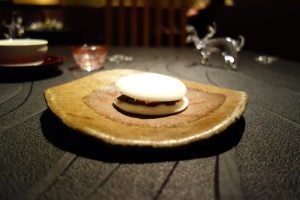
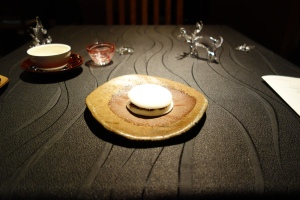

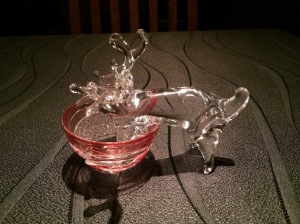




 (hot) Seasonal Vegetables with Pine Nuts dressing. Array of Flavors and Textures in one plate. (4.75/5)
(hot) Seasonal Vegetables with Pine Nuts dressing. Array of Flavors and Textures in one plate. (4.75/5)






















